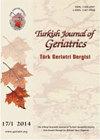The Effects of Low Flow and Normal Flow Desflurane Anesthesia on Liver and Renal Functions and Serum Cystatin C Levels in Geriatric Patients: A Prospective Randomized Controlled Study
IF 0.3
4区 医学
Q4 GERIATRICS & GERONTOLOGY
Turkish Journal of Geriatrics-Turk Geriatri Dergisi
Pub Date : 2023-03-01
DOI:10.29400/tjgeri.2023.332
引用次数: 0
Abstract
Introduction: Aging is a physiological process and the elderly population is increasing. In parallel to the increasing of the elderly population, the number of geriatric patients who required an invasive procedure or surgical intervention under anesthesia are also increasing. The geriatric patients who are frailty and have a loss of functional reserve in all organ systems are more sensitive to anesthetic agents. The purpose of this research was to investigate whether low flow desflurane anesthesia also affects hepatic and kidney functions, in elderly patients. Methods: After approval from the local ethics committee, the patients were divided into two groups; as the low flow desflurane anesthesia group and the normal flow desflurane anesthesia group using the closed-envelope method. Calibration and leakage tests of the anesthesia device (Primus, Drager) were performed before anesthesia. Heamodynamics parametres, peripheral oxygen saturation, and bispectral index monitoring were performed to all patients in operating room. The blood samples were collected before anesthesia induction, after surgery, and at the postoperative 24th hour. The serum alanine aminotransferase and aspartate aminotransferase levels were measured to assess the liver damage. The serum creatinine, blood urea nitrogen, and cystatin C levels were measured to assess the kidney function. Results: The serum alanine aminotransferase, aspartate aminotransferase, blood urea nitrogen, creatinine and cystatin C levels and hemodynamic parameters, peripheral oxygen saturation and bispectral index values were similar in both groups. Conclusions: It was concluded that low-flow desflurane anesthesia does not adversely affect liver and kidney functions in geriatric patients and is as safe as normal-flow desflurane anesthesia. Keywords: Anesthesia; Cystatin C; Desflurane; Aged; Kidney; Liver.低流量和正常流量地氟醚麻醉对老年患者肝肾功能和血清胱抑素C水平的影响:一项前瞻性随机对照研究
老龄化是一个生理过程,老年人口在不断增加。随着老年人口的增加,需要在麻醉下进行有创手术或手术干预的老年患者数量也在增加。体弱多病和所有器官系统功能储备丧失的老年患者对麻醉剂更为敏感。本研究的目的是探讨低流量地氟醚麻醉是否也会影响老年患者的肝肾功能。方法:经当地伦理委员会批准,将患者分为两组;为低流量地氟醚麻醉组和正常流量地氟醚麻醉组,采用密闭包络法。麻醉前对麻醉装置(Primus, Drager)进行校准和泄漏试验。对所有患者进行血流动力学参数、外周血氧饱和度、双谱指标监测。分别于麻醉诱导前、手术后及术后24小时采集血样。测定血清丙氨酸转氨酶和天冬氨酸转氨酶水平,评估肝损害程度。测定血清肌酐、尿素氮、胱抑素C水平评价肾功能。结果:两组患者血清丙氨酸转氨酶、天冬氨酸转氨酶、尿素氮、肌酐、胱抑素C水平及血流动力学参数、外周血氧饱和度、双谱指数均无明显差异。结论:低流量地氟醚麻醉对老年患者的肝肾功能没有不良影响,与正常流量地氟醚麻醉一样安全。关键词:麻醉;半胱氨酸蛋白酶抑制物C;地氟醚;岁的;肾脏;肝脏。
本文章由计算机程序翻译,如有差异,请以英文原文为准。
求助全文
约1分钟内获得全文
求助全文
来源期刊

Turkish Journal of Geriatrics-Turk Geriatri Dergisi
GERIATRICS & GERONTOLOGY-
CiteScore
0.60
自引率
0.00%
发文量
46
审稿时长
6-12 weeks
期刊介绍:
Turkish Journal of Geriatrics is a peer-reviewed journal. Official language of the journal is English. Turkish Journal of Geriatrics invites submission of Original Articles based on clinical and laboratory studies. Review Articles are published only after the invitation from the Editorial Board.
 求助内容:
求助内容: 应助结果提醒方式:
应助结果提醒方式:


